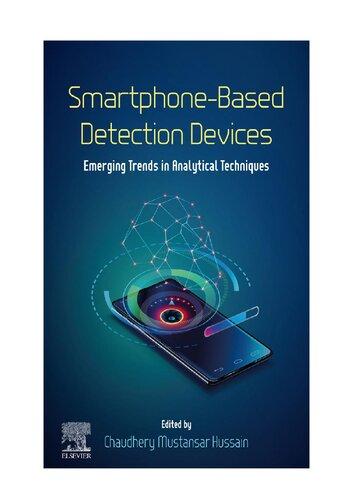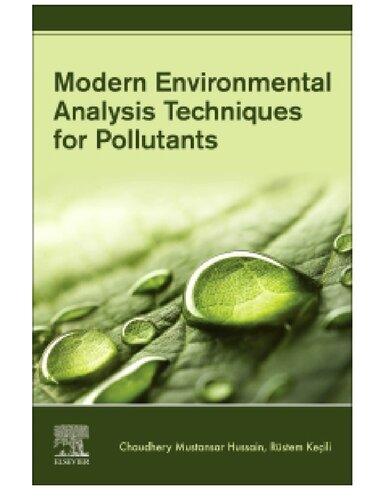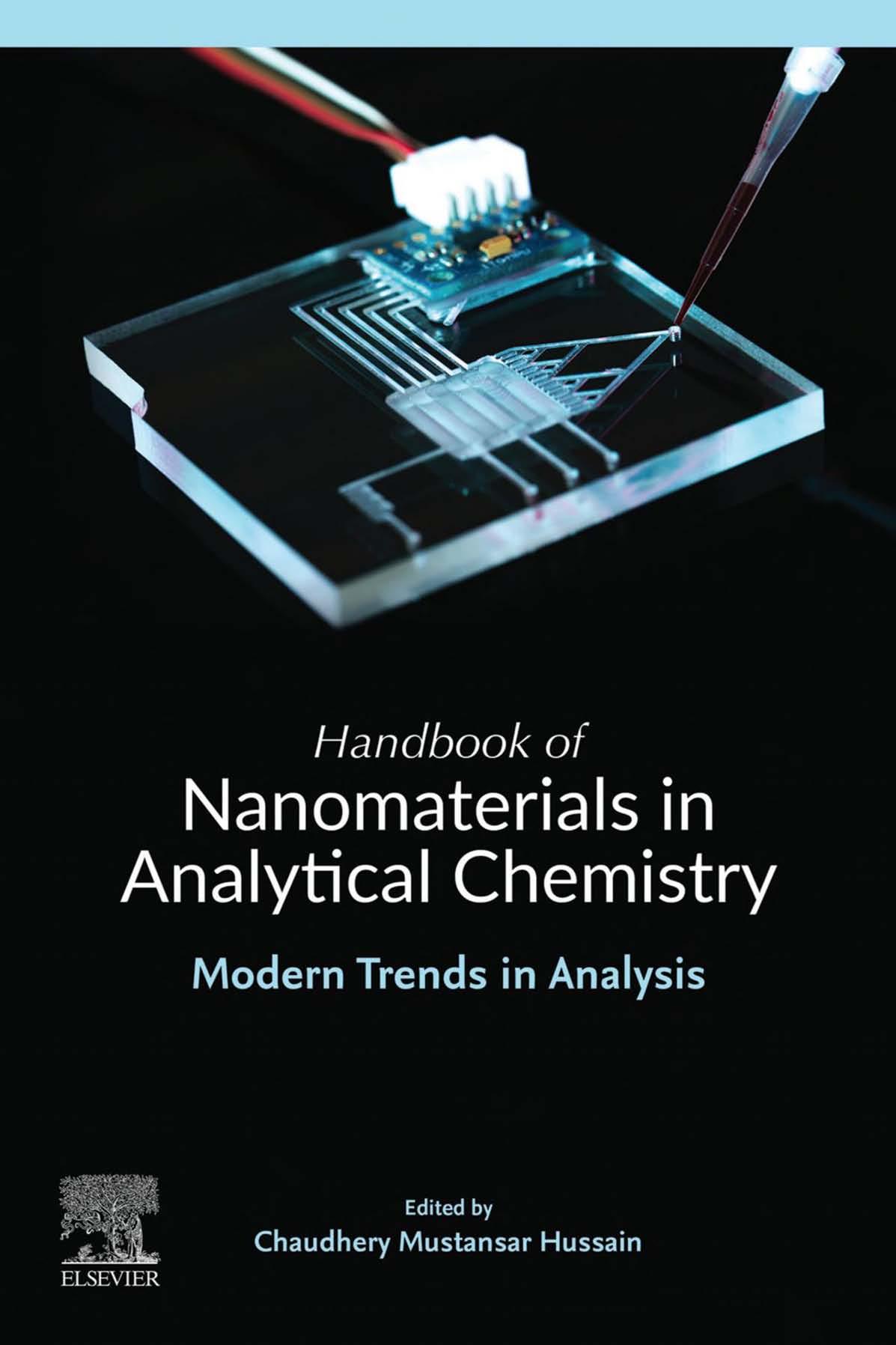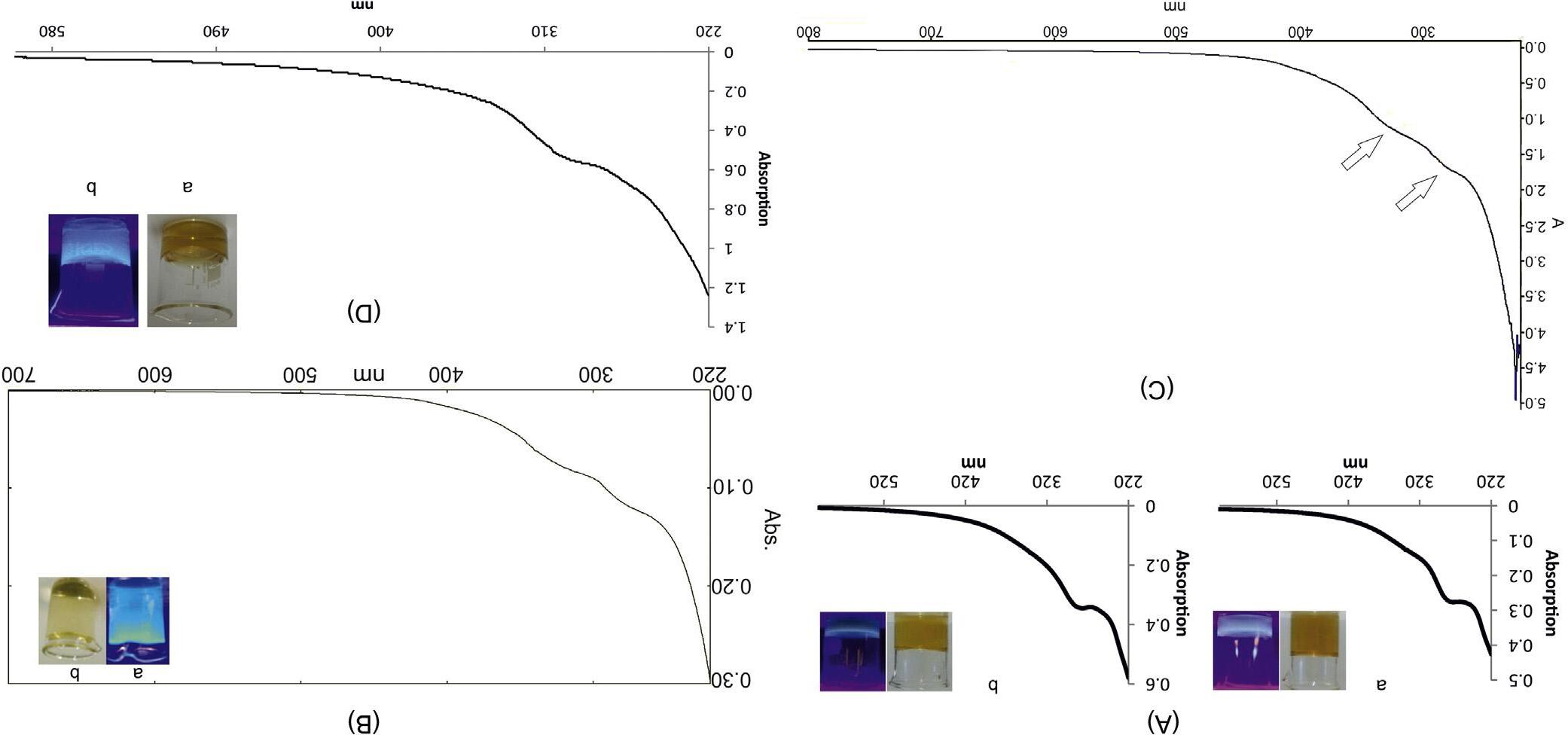https://ebookmass.com/product/handbook-of-nanomaterials-in-
Instant digital products (PDF, ePub, MOBI) ready for you
Download now and discover formats that fit your needs...
Handbook on Miniaturization in Analytical Chemistry: Application of Nanotechnology 1st Edition Chaudhery Mustansar Hussain
https://ebookmass.com/product/handbook-on-miniaturization-inanalytical-chemistry-application-of-nanotechnology-1st-editionchaudhery-mustansar-hussain/ ebookmass.com
Smartphone-Based Detection Devices: Emerging Trends in Analytical Techniques 1st Edition Chaudhery Mustansar Hussain (Editor)
https://ebookmass.com/product/smartphone-based-detection-devicesemerging-trends-in-analytical-techniques-1st-edition-chaudherymustansar-hussain-editor/
ebookmass.com
Modern Environmental Analysis Techniques for Pollutants Chaudhery Mustansar Hussain
https://ebookmass.com/product/modern-environmental-analysistechniques-for-pollutants-chaudhery-mustansar-hussain/
ebookmass.com
Diagnostic Imaging: Brain 4th Edition Miral D. Jhaveri
https://ebookmass.com/product/diagnostic-imaging-brain-4th-editionmiral-d-jhaveri/
ebookmass.com
The Next Best Day Sharon Sala
https://ebookmass.com/product/the-next-best-day-sharon-sala-2/
ebookmass.com
Macroeconomics: A European Perspective 3rd Edition Olivier Blanchard
https://ebookmass.com/product/macroeconomics-a-europeanperspective-3rd-edition-olivier-blanchard/
ebookmass.com
Complexity Economics: Building a New Approach to Ancient Economic History Koenraad Verboven
https://ebookmass.com/product/complexity-economics-building-a-newapproach-to-ancient-economic-history-koenraad-verboven/
ebookmass.com
The Girl in His Shadow Amelia Blake
https://ebookmass.com/product/the-girl-in-his-shadow-amelia-blake/
ebookmass.com
5 Steps to a 5: AP Calculus BC 2022 1st Edition William Ma
https://ebookmass.com/product/5-steps-to-a-5-ap-calculus-bc-2022-1stedition-william-ma/
ebookmass.com
After the Lights Go Down Donna Hill
https://ebookmass.com/product/after-the-lights-go-down-donna-hill-2/
ebookmass.com
HandbookofNanomaterialsin AnalyticalChemistry
Handbookof Nanomaterialsin AnalyticalChemistry
ModernTrendsinAnalysis
Editedby
ChaudheryMustansarHussain DepartmentofChemistryand EnvironmentalScience, NewJerseyInstituteofTechnology, Newark,NJ,UnitedStates
Elsevier
Radarweg29,POBox211,1000AEAmsterdam,Netherlands TheBoulevard,LangfordLane,Kidlington,OxfordOX51GB,UnitedKingdom 50HampshireStreet,5thFloor,Cambridge,MA02139,UnitedStates
Copyright©2020ElsevierInc.Allrightsreserved.
Nopartofthispublicationmaybereproducedortransmittedinanyformorbyanymeans,electronicor mechanical,includingphotocopying,recording,oranyinformationstorageandretrievalsystem,without permissioninwritingfromthepublisher.Detailsonhowtoseekpermission,furtherinformationabout thePublisher’spermissionspoliciesandourarrangementswithorganizationssuchastheCopyright ClearanceCenterandtheCopyrightLicensingAgency,canbefoundatourwebsite: www.elsevier.com/ permissions.
ThisbookandtheindividualcontributionscontainedinitareprotectedundercopyrightbythePublisher (otherthanasmaybenotedherein).
Notices
Knowledgeandbestpracticeinthisfieldareconstantlychanging.Asnewresearchandexperience broadenourunderstanding,changesinresearchmethods,professionalpractices,ormedicaltreatment maybecomenecessary.
Practitionersandresearchersmustalwaysrelyontheirownexperienceandknowledgeinevaluatingand usinganyinformation,methods,compounds,orexperimentsdescribedherein.Inusingsuch informationormethodstheyshouldbemindfuloftheirownsafetyandthesafetyofothers,including partiesforwhomtheyhaveaprofessionalresponsibility.
Tothefullestextentofthelaw,neitherthePublishernortheauthors,contributors,oreditors,assume anyliabilityforanyinjuryand/ordamagetopersonsorpropertyasamatterofproductsliability, negligenceorotherwise,orfromanyuseoroperationofanymethods,products,instructions,orideas containedinthematerialherein.
BritishLibraryCataloguing-in-PublicationData
AcataloguerecordforthisbookisavailablefromtheBritishLibrary LibraryofCongressCataloging-in-PublicationData
AcatalogrecordforthisbookisavailablefromtheLibraryofCongress ISBN:978-0-12-816699-4
ForInformationonallElsevierpublications visitourwebsiteat https://www.elsevier.com/books-and-journals
Publisher: SusanDennis
AcquisitionEditor: KathrynEryilmaz
EditorialProjectManager: ReddingMorse
ProductionProjectManager: SwapnaSrinivasan
CoverDesigner: ChristianJ.Bilbow
TypesetbyMPSLimited,Chennai,India
Listofcontributorsxi
SectionIModernageofanalytical chemistry—Nanomaterials(NMs)1
1Carbonnanodotsfromnatural(re)sources:anewperspective onanalyticalchemistry3 Th.G.ChatzimitakosandC.D.Stalikas
1.1Introduction3
1.2Synthesisofcarbonnanodots4
1.3Characteristicsofcarbonnanodots8 1.4Analyticalapplicationsofcarbonnanodotsfluorescencesystems13 1.5MechanismsofCND-basedphotoluminescentanalyticalsystems20 1.6Conclusions21 References22
2Modernageofanalyticalchemistry:nanomaterials29
SibelBu¨yu¨ktiryaki,Ru¨stemKec¸iliandChaudheryMustansarHussain
2.1Introduction29
2.2Historyofanalyticalchemistry30 2.3Historyofnanotechnology32
2.4Classificationofnanomaterialsandapplicationofnanomaterials astoolsandanalytes32
2.5Conclusions36 References37
SectionIINanomaterials(NMs)insamplepreparation41
3Nanomaterialsformicroextractiontechniquesinbioanalysis43 MohammadMahdiMoein,AbbiAbdel-Rehim andMohamedAbdel-Rehim
3.1Introduction43
3.2Nanomaterialsclassifications44
3.3Nanomaterialsapplicationinmicroextractionmethods46
3.4Recentnanomaterialsapplicationsinmicroextractiontechniques46
3.5Concludingremarks52 References52
4Recentadvancesinsolid-phaseextractiontechniques withnanomaterials57
YingyingWen
4.1Introduction57
4.2Theapplicationofnanomaterialsinsamplepreparation58
4.3Conclusion66 Acknowledgment67 References67
5Theuseofmagneticnanoparticlesinsamplepreparationdevices andtools75
RustemKec¸ili,SibelBuyuktiryaki, IbrahimDolak andChaudheryMustansarHussain
5.1Introduction75
5.2Synthesisofmagneticnanoparticles76
5.3Solid-phaseextraction79
5.4Magneticsolid-phaseextraction79
5.5Conclusionandfuturetrends89 References90
SectionIIINanomaterials(NMs)inseparation97
6Separationtechniqueswithnanomaterials99
PrasadMinakshi,MayukhGhosh,BasantiBrar,KoushleshRanjan, HarshadSudhirPatkiandRajeshKumar
6.1Introduction99
6.2Nanomaterialsinseparationtechniques101
6.3Separationtechniqueswithnanomaterials108
6.4Potentialapplicationsofnanomaterial-basedseparation techniques136
6.5Conclusionsandfutureprospects139 References139 Furtherreading158
7Membraneapplicationsofnanomaterials159
Ru¨stemKec¸ili,SibelBu¨yu¨ktiryakiandChaudheryMustansarHussain
7.1Introduction159
7.2Traditionalmembranes159
7.3Carbonnanomaterial-basedmembranes160
7.4Nanoparticle-basedmembranes167
7.5Molecularlyimprintedpolymer-basedmembranes169
7.6Conclusionsandfuturetrends175 References176
SectionIVNanomaterials(NMs)inIntegration (micro-TAS&LabonChipAnalyticalchemistry withNanomaterials(NMs)183
8Micrototalanalysissystemswithnanomaterials185 Ru¨stemKec¸ili,SibelBu¨yu¨ktiryakiandChaudheryMustansarHussain
8.1Introduction185
8.2Thecomponentsofmicrototalanalysissystems186
8.3Advantagesanddisadvantagesofmicrototalanalysissystems188
8.4Applicationsofmicrototalanalysissystems188
8.5Conclusions195 References195
SectionVNanomaterials(NMs)indetection199
9Electrochemicallyengineerednanoporousphotoniccrystal structuresforopticalsensingandbiosensing201 CherylSuwenLaw,Lluı´sF.MarsalandAbelSantos
9.1Introduction201
9.2Fabricationandproperties:nanoporousanodicaluminaas effectivemedium203
9.3Nanoporousanodicaluminaphotoniccrystalsasopticalsensing platforms207
9.4Conclusions219 References220 Furtherreading226
10Pressureandtemperatureopticalsensors:luminescence oflanthanide-dopednanomaterialsforcontactlessnanomanometry andnanothermometry227 MarcinRunowski
10.1Introduction227
10.2Temperaturemeasurements—generalremarks229
10.3Remote,contactlesstemperaturesensing231 10.4Nanothermometry234
10.5High-pressuremeasurements—generalremarks253
10.6High-pressureluminescencemeasurements254
10.7Opticalnanosensorsofpressure—nanomanometry258 10.8Concludingremarks263 References265
11Nanoparticle-integratedelectrochemicaldevicesforidentification ofmycotoxins275
SureshKumarKailasa,TaeJungPark,RakeshKumarSinghal andHirakenduBasu
11.1Introduction275
11.2Surfacemodificationofelectrodesforelectrochemicalsensing ofmycotoxins276
11.3Summary288 Acknowledgments291 References291 Furtherreading296
12Functionalnanomaterial-derivedelectrochemicalsensorand biosensorplatformsforbiomedicalapplications297 GovindhanMaduraiveeranandWeiJin
12.1Introduction297
12.2Noblemetallicnanoparticles299
12.3Metaloxidenanomaterials304
12.4Carbonnanomaterials306
12.5Polymernanomaterials313
12.6Bionanomaterials317
12.7Conclusion319 Acknowledgments320 References320
13Nanomaterial-basedsensors329
FabianaArduini,StefanoCinti,VivianaScognamiglio andDanilaMoscone
13.1Introduction329
13.2Graphene331
13.3Carbonnanotubes335
13.4Othercarbon-basedmaterials339
13.5Non-carbonaceousnanomaterials342
13.6Nano/micromotors352 13.7Conclusions354 Acknowledgments354 References355
14MXene-basedsensorsandbiosensors:next-generationdetection platforms361
AnkitaSinha,Dhanjai,SamuelM.Mugo,JipingChen andKoodlurS.Lokesh 14.1Introduction361
14.2MXene-basedsensingandbiosensingforvariousanalytes363 14.3Conclusion370 References370
SectionVIFunctionalizednanomaterialsforanalytical chemistry373
15Functionalizednanomaterialsforsamplepreparationmethods375 ErkanYilmazandMustafaSoylak Abbreviations375 15.1Introduction376
15.2Functionalizednanomaterialsforsamplepreparationmethods379 15.3Conclusion402 References402 Furtherreading413
16Surface-modifiedmetalnanoparticlesforrecognitionoftoxic organicmolecules415
SureshKumarKailasa,RakeshKumarSinghal,HirakenduBasu andTaeJungPark
16.1Introduction415
16.2Colorimetricrecognitionofpesticidesbysurface-modified Agnanoparticles416 16.3Colorimetricrecognitionofpesticidesbysurface-modified Aunanoparticles420 16.4Summary429 Acknowledgment429 References429
SectionVIINanomaterials:risk,toxicity,and regulatorynorms433
17Safetyrisk,ELSI(ethical,legal,socialissues),andeconomics ofnanomaterials435 GustavoMarquesdaCostaandChaudheryMustansarHussain 17.1Introduction435
17.2Nanomaterialsandenvironment437 17.3Economics,modernpolicy,andlegalizationofnanotechnology441 17.4Conclusionandfuturetrends442 References444 Furtherreading446
SectionVIIIAnalysisofNanomaterials447
18Advancedmicro-andnanoscalecharacterizationtechniques forcarbonaceousaerosols449 ShahadevRabhaandBinoyK.Saikia
18.1Introduction449
18.2Analyticalcharacterizationtechniques451 18.3Summary465 References465
19Issuesrelatedwiththeanalysisofnanomaterials473
ChristineVauthier
Abbreviations473
19.1Introduction473
19.2Nanomaterialcharacteristics:identifyingkeyattributes475
19.3Analyzingnanomaterialphysicalattributeswithautomatedand standardizedmethods477
19.4Analyzingattributesofnanomaterialsusingothermethods481 19.5Conclusion486 References486
Furtherreading490
SectionIXFutureofanalyticalchemistrywith
20Graphenequantumdotsinbiomedicalapplications:recent advancesandfuturechallenges493
XianxianZhao,WeiyinGao,HongZhang,XiaopeiQiuandYangLuo 20.1Syntheticconsiderations494
20.2Biomedicalapplicationsofgraphenequantumdots495 20.3Toxicityresearchofgraphenequantumdotmaterials500 20.4Conclusionandperspectives501 References502
Index507
Listofcontributors
AbbiAbdel-Rehim FacultyofScienceandEngineering,Universityof Manchester,Manchester,UnitedKingdom
MohamedAbdel-Rehim DepartmentofClinicalNeuroscience,Centerfor PsychiatryResearch,KarolinskaInstituteandStockholmCountyCouncil, Stockholm,Sweden;FunctionalMaterialsDivision,DepartmentofApplied Physics,SchoolofEngineeringSciences,KTHRoyalInstituteofTechnology, Isafjordsgatan22,Kista,SE-16440Stockholm,Sweden
FabianaArduini DepartmentofChemicalScienceandTechnologies,University ofRome“TorVergata”,Rome,Italy
HirakenduBasu AnalyticalChemistryDivision,BhabhaAtomicResearchCenter, Trombay,Mumbai,India
BasantiBrar DepartmentofAnimalBiotechnology,LLRUniversityofVeterinary andAnimalSciences,Hisar,India
SibelBu ¨ yu ¨ ktiryaki YunusEmreVocationalSchoolofHealthServices, DepartmentofMedicalServicesandTechniques,AnadoluUniversity,Eskis¸ehir, Turkey
Th.G.Chatzimitakos DepartmentofChemistry,UniversityofIoannina,Ioannina, Greece
JipingChen CASKeyLaboratoryofSeparationScienceforAnalyticalChemistry, DalianInstituteofChemicalPhysics,ChineseAcademyofSciences,DalianP.R. China
StefanoCinti DepartmentofPharmacy,UniversityofNaples“FedericoII”,Rome, Italy
GustavoMarquesdaCosta TechnologyandEnvironmentalManagement, FeevaleUniversity,NovoHamburgo,Brazil
Dhanjai DepartmentofMathematicalandPhysicalSciences,ConcordiaUniversity ofEdmonton,Edmonton,AB,Canada;DepartmentofPhysicalSciences,MacEwan University,Edmonton,AB,Canada;CASKeyLaboratoryofSeparationScience forAnalyticalChemistry,DalianInstituteofChemicalPhysics,ChineseAcademy ofSciences,DalianP.R.China
I
˙ brahimDolak VocationalSchoolofTechnicalSciences,DicleUniversity, Diyarbakır,Turkey
WeiyinGao DepartmentofUrology,TheSecondAffiliatedHospitalofNanchang University,Nanchang,P.R.China
MayukhGhosh DepartmentofVeterinaryPhysiologyandBiochemistry,Lala LajpatRaiUniversityofVeterinaryandAnimalSciences,Hisar,India
ChaudheryMustansarHussain DepartmentofChemistryandEnvironmental Science,NewJerseyInstituteofTechnology,Newark,NJ,UnitedStates
WeiJin NationalEngineeringLaboratoryforHydrometallurgicalCleaner ProductionTechnology,KeyLaboratoryofGreenProcessandEngineering,Institute ofProcessEngineering,ChineseAcademyofSciences,Beijing,P.R.China
SureshKumarKailasa DepartmentofAppliedChemistry,S.V.NationalInstitute ofTechnology,Surat,India
Ru ¨ stemKec¸ili YunusEmreVocationalSchoolofHealthServices,Departmentof MedicalServicesandTechniques,AnadoluUniversity,Eskis¸ehir,Turkey
RajeshKumar DepartmentofVeterinaryPhysiology,COVAS,KVASU, Pookode,India
CherylSuwenLaw SchoolofChemicalEngineeringandAdvancedMaterials, TheUniversityofAdelaide,Adelaide,SA,Australia;InstituteforPhotonicsand AdvancedSensing(IPAS),TheUniversityofAdelaide,Adelaide,SA,Australia; ARCCentreofExcellenceforNanoscaleBioPhotonics(CNBP),TheUniversityof Adelaide,Adelaide,SA,Australia
KoodlurS.Lokesh DepartmentofChemistry/IndustrialChemistry,Vijayanagara SriKrishnadevarayaUniversity,Ballari,India
YangLuo KeyLaboratoryforBiorheologicalScienceandTechnologyofMinistry ofEducation,StateandLocalJointEngineeringLaboratoryforVascularImplants, BioengineeringCollegeofChongqingUniversity,Chongqing,P.R.China;Center ofLaboratoryMedicine,MedicalSchoolofChongqingUniversity,Chongqing,P.R. China
GovindhanMaduraiveeran MaterialElectrochemistryLaboratory,Departmentof Chemistry,SRMInstituteofScienceandTechnology,Kattankulathur,TamilNadu, India
Lluı´sF.Marsal DepartmentofElectronic,Electric,andAutomaticsEngineering, UniversitatRoviraiVirgili,Tarragona,Tarragona,Spain
PrasadMinakshi DepartmentofAnimalBiotechnology,LLRUniversityof VeterinaryandAnimalSciences,Hisar,India
MohammadMahdiMoein DepartmentofClinicalNeuroscience,Centerfor PsychiatryResearch,KarolinskaInstituteandStockholmCountyCouncil, Stockholm,Sweden
DanilaMoscone DepartmentofChemicalScienceandTechnologies,Universityof Rome“TorVergata”,Rome,Italy
SamuelM.Mugo DepartmentofPhysicalSciences,MacEwanUniversity, Edmonton,AB,Canada
TaeJungPark DepartmentofChemistry,InstituteofInterdisciplinary ConvergenceResearch,ResearchInstituteofHalalIndustrializationTechnology, Chung-AngUniversity,84Heukseok-ro,Dongjak-Gu,Seoul,RepublicofKorea
HarshadSudhirPatki DepartmentofVeterinaryAnatomyandHistology, COVAS,KVASU,Pookode,India
XiaopeiQiu DepartmentofUrology,TheSecondAffiliatedHospitalofNanchang University,Nanchang,P.R.China
ShahadevRabha PolymerPetroleumandCoalChemistryGroup,Materials ScienceandTechnologyDivision,CSIR-NorthEastInstituteofScienceand Technology,Jorhat,India
KoushleshRanjan DepartmentofVeterinaryPhysiologyandBiochemistry, COVAS,SVPUniversityofAgricultureandTechnology,Meerut,India
MarcinRunowski FacultyofChemistry,AdamMickiewiczUniversity,Poznan ´ , Poland
BinoyK.Saikia AcademyofScientificandInnovativeResearch,CSIR-NEIST Campus,Jorhat,India
AbelSantos SchoolofChemicalEngineeringandAdvancedMaterials,The UniversityofAdelaide,Adelaide,SA,Australia;InstituteforPhotonicsand AdvancedSensing(IPAS),TheUniversityofAdelaide,Adelaide,SA,Australia; ARCCentreofExcellenceforNanoscaleBioPhotonics(CNBP),TheUniversityof Adelaide,Adelaide,SA,Australia
VivianaScognamiglio InstituteofCrystallography,DepartmentofChemical SciencesandMaterialsTechnologies,MonterotondoScalo,Rome,Italy
RakeshKumarSinghal AnalyticalChemistryDivision,BhabhaAtomicResearch Center,Trombay,Mumbai,India
AnkitaSinha KeyLaboratoryofIndustrialEcologyandEnvironmental Engineering(MinistryofEducation,China),SchoolofEnvironmentalScienceand Technology,DalianUniversityofTechnology,Dalian,P.R.China
MustafaSoylak FacultyofSciences,DepartmentofChemistry,Erciyes University,Kayseri,Turkey
C.D.Stalikas DepartmentofChemistry,UniversityofIoannina,Ioannina,Greece
ChristineVauthier InstitutGalienParis-Sud,UMRCNRS8612,UniversityParisSud,Chatenay-MalabryCedex,France
YingyingWen EnvironmentalScience,HainanMedicalUniversity,Haikou,P.R. China
ErkanYilmaz FacultyofPharmacy,DepartmentofAnalyticalChemistry,Erciyes University,Kayseri,Turkey;NanotechnologyResearchCenter(ERNAM),Erciyes University,Kayseri,Turkey
HongZhang KeyLaboratoryforBiorheologicalScienceandTechnologyof MinistryofEducation,StateandLocalJointEngineeringLaboratoryforVascular Implants,BioengineeringCollegeofChongqingUniversity,Chongqing,P.R.China
XianxianZhao KeyLaboratoryforBiorheologicalScienceandTechnologyof MinistryofEducation,StateandLocalJointEngineeringLaboratoryforVascular Implants,BioengineeringCollegeofChongqingUniversity,Chongqing,P.R. China;DepartmentofLaboratoryMedicalScience,SouthwestHospital,Third MilitaryMedicalUniversity,Chongqing,P.R.China
Carbonnanodotsfromnatural (re)sources:anewperspectiveon analyticalchemistry
Th.G.ChatzimitakosandC.D.Stalikas DepartmentofChemistry,UniversityofIoannina,Ioannina,Greece
1.1Introduction
1
Nanomaterialsareunequivocallyauniqueclassofmaterialswithexceptionalproperties,whichhavefosteredmanyunprecedentedapplications [1].Carbonnanodots (CNDs)constituteanovelclassofcarbon-basednanomaterials,whichwerediscoveredin2004duringthepurificationofsingle-walledcarbonnanotubes.Theypossessstrongandtunablefluorescenceproperties,whichenabletheirapplicationsin fieldssuchasbiomedicine,optronics,chemistry,andcatalysis.Thesematerialscan furtherbefunctionalizedwithbiomolecules,arelesstoxic,chemicallyinert,and canbeusedaseffectivecarriersfordrugdelivery,biologicalimaging,andanalyticalapplications.Comparedwiththetraditionalsemiconductorquantumdots,the upconvertingnanoparticlesandtheorganicdyes,thephotoluminescent(PL)CNDs showmanyadvantages,includinghighphotostability,highaqueoussolubility, robustchemicalinertness,andeasymodification.
Inrecentyears,variouschemicalprecursorshavebeenidentifiedforthesynthesisofCNDs,includingcitricacid [2],ammoniumcitrate [3],ethyleneglycol [4], phyticacid [5],EDTA [6],thiourea [7] andsoon.Varioussyntheticrouteshave beenusedtoconverttheseprecursorsintofluorescentCNDs,includinghydrothermal [8,9],solvothermal [10],electrochemicaltreatment [11],microwave-assisted pyrolysis [12],ultrasonication [13],thermalcarbonization [14],atmosphericplasma synthesis [15],chemicaloxidation [16],exfoliationofgraphiteinorganicsolvent bymodifiedHummer’smethod [17] andsoon.Generally,CNDsaresynthesized bybothtop-downandbottom-upmethodsmotivatingaconstantpersuasionof benignsyntheticroutes.
TherawcarbonsourcesforCNDscanbeeitherman-made,forexample,candle soot,graphite,fullerene-C60,ammoniumcitrate,glucose,urea,andethylenediamine [18 22] ornaturalproducts(e.g.,orangejuice,milk,coffeegrounds,green tea,egg,soymilk,flour,banana,potato,pepper,honey,garlic,aloe,roseflowers, hair,andricehusks) [15,23 38].Natureoffersawealthofexcitingprecursorsthat inspirescientiststodevelopnewmaterialswithnovelapplicationsandlessof anenvironmentalorhumanimpact.Naturalproductshaveanedgeoverchemical precursors.Firstly,theyarerenewableandhavegoodbiocompatibility. HandbookofNanomaterialsinAnalyticalChemistry.DOI: https://doi.org/10.1016/B978-0-12-816699-4.00001-3 Copyright © 2020ElsevierInc.Allrightsreserved.
Secondly,naturalproductscontainheteroatoms,whichfacilitatethefabricationof heteroatom-dopedCNDswithouttheadditionofanexternalheteroatomsource. Finally,somenaturalproductscanbeusedtoprepareCNDsinwaysthataregreen andsimplerelativetotraditionalmethods,forthepreparationofcarbondotsfrom man-madecarbonsources.Asanadditionalbenefit,thepreparationofCNDsfrom naturalproductscanconvertlow-valuebiomasswasteintovaluableanduseful materials.Naturalproductsthatcontainheteroatoms(N,S)areverysuitableraw materialsforthepreparationofheteroatom-dopedCNDs,unlikeotherN/S-doped CNDsderivedfromman-madecarbonsourcesthatrequiretheadditionof N/S-containingcompounds.
Inthischapter,wewilldiscussthelatestdevelopmentsinCNDswithrespectto natural(re)sources(theterm“naturalsources”henceforthwillbeusedtodescribe naturalsources,resources,andwastematerialsfromnatural(re)sources),asraw carbonandnitrogenand/orsulfursources.Thefirstpartofthechapterfocuseson thedifferentmethodsthatcanbefollowedtoproduceCNDsfromnaturalsources andtheirstructuralandPLcharacteristicstogainaninsightintotheuniquepropertiesofCNDs.ThesecondpartdiscussesparticularapplicationsofCNDsinanalyticalchemistryandthemechanismsinvolvedinthefluorescenceofCNDs.
1.2Synthesisofcarbonnanodots
TheapplicationsofCNDsrely,mostly,ontheirPLproperties.Therefore,forthe productionoffunctionalCNDs,thesepropertiesmustbetakenintoaccount.Ingeneral,thePLofCNDsisderived,mainly,fromtheradiativerecombinationofsurfaceenergytrapsandphotoexcitedelectronsandleadstotheemissionoflower energy [39,40].Thistypeofemissiondependsonboththecoreandsurfaceofthe CNDs.Takingunderconsiderationtheabove,itisconceivedthatthemethod employedandtherespectiveconditionsofthesynthesisplayakeyroleinthefunctionalpropertiesoftheCNDs.Uptonow,thesyntheticapproachesforproducing CNDshavebeendividedintotwomaingroups:thebottom-upandthetop-down. Thebottom-upmethods,commonly,refertothe“grow”ofprecursormaterialsto CNDs.Methodsthatadheretothisapproach,usesimplecarbonaceousmaterials, suchascitricacid,glucose,andothersimplecompounds,asasourceofnitrogen and/orsulfur,asadopant [41,42].However,theseapproachesarescarcelyusedto produceCNDsfromnaturalsources [43].Top-downapproachesrefertotheproductionofCNDsfrommacroscopiccarbonsources,suchasplantsandwaste(representativecasesarepresentedin Fig.1.1).Next,wewillfocusontheseapproaches owingtotheirwidespreaduseintheproductionofCNDsfromnaturalsources.
1.2.1Solvothermalcarbonization
Solvothermalcarbonizationisthemostwidelyemployedapproachtoproduce CNDsfromnaturalsources.Typically,asamplefromaselectednaturalsourceis 4HandbookofNanomaterialsinAnalyticalChemistry
Figure1.1 SchematicillustrationofCND(CQDs:carbonquantumdots)synthesisusingtop-downapproachesfrom(A)pyrolysisof Citrus sinensis and Citruslimon peels,(B)pyrolysisappleseeds,(C)pyrolysisofhumanfingernails,and(D)microwavetreatmentofhumanfingernails.
Source:ReprintedfromT.Chatzimitakos,A.Kasouni,L.Sygellou,I.Leonardos,A.Troganis,C.Stalikas,Humanfingernailsasanintriguing precursorforthesynthesisofnitrogenandsulfur-dopedcarbondotswithstrongfluorescentproperties:analyticalandbioimagingapplications, Sens.ActuatorsB267(2018)494 501;T.Chatzimitakos,A.Kasouni,L.Sygellou,A.Avgeropoulos,A.Troganis,C.Stalikas,Twoofakind butdifferent:luminescentcarbonquantumdotsfromcitruspeelsforironandtartrazinesensingandcellimaging,Talanta175(2017)305 312; A.Chatzimarkou,T.Chatzimitakos,A.Kasouni,L.Sygellou,A.Avgeropoulos,C.D.Stalikas,SelectiveFRET-basedsensingof4-nitrophenol andcellimagingcapitalizingonthefluorescentpropertiesofcarbonnanodotsfromappleseeds,Sens.ActuatorsB258(2018)1152 1160,with permissionfromElsevier,andT.Chatzimitakos,A.Kasouni,A.Troganis,C.Stalikas,Carbonizationofhumanfingernails:towardthe sustainableproductionofmultifunctionalnitrogenandsulfurcodopedcarbonnanodotswithhighlyluminescentprobingandcellproliferative/ migrationproperties,ACSAppl.Mater.Interfaces10(2018)16024 16032fromAmericanChemicalSociety.
placedeitherdirectlyorafterspecificpretreatmentinanautoclave,alongwith water(hydrothermal)ororganicsolventandthesystemisheatedtoacertaintemperature(typicallyintherangeof180 C 280 C),forfewhours.Aftercompletion oftheprocedure,theresultingliquidorviscousmaterial(containingtheCNDs)is subjectedtofurthertreatmenttoisolateorpurifytheCNDs.Simplicity,lowcost, andenvironmentalfriendlinessarethemajoradvantagesofthisapproach,which triggeredtheinterestofresearchgroupstoemployit [30,33,43,47 49]. Multitudinousnaturalsources,includingstrawberryjuice [49],aloevera [33],wool [50],onionwaste [51],waterchestnut [52],driedlemonpeel [53],etc.,have yieldedCNDsafterhydrothermaltreatment.Liuetal.producedN-dopedCNDs (quantumyield(QY):17.1%)fromthehydrothermaltreatmentofgoosefeathersat 180 Cfor40min [54].Thisamountoftimeistheshortestreportedforthehydrothermaltreatmentprocessofanaturalsource.Contrarytothepreviousreport, Zhangetal.spent48htoproduceN-dopedCNDsfromeggwhite,afterhydrothermaltreatmentat220 C,butwithsignificantlyhigherQY(i.e.,64%)comparedwiththepreviouscase [55] .Fromtheabovetwostudies,itiseasily concludedthatasidefromthecarbonsour ce,theconditionsofthehydrothermal treatment,maysignificantlyaffect theproducedCNDs.Xuetal.,inaneffort toproduceN,S-dopedCNDsfrom Enteromorphaprolifera showedthatlower heatingtemperaturesandshortert reatmentperiodsoftime(e.g.,150 Cfor3h) yieldaggregatedcarbonnanopartic leswithincreaseddiameter(i.e., 30 140nm) [56] .Increasingthetemperatureto180 Creducedtheaggregation ofthecarbonnanoparticles,whilelonger time(6h)yielded,almostsolely,nonaggregatedCNDs.FurtherincreaseintemperatureortimedidnotyieldCNDs ofhigherfluorescenceorbetterPLchara cteristics.Althoughtemperatureand timearethetwodeterminingfactorsfo rtheproductionofCNDsfromhydrothermaltreatment,theireffectcannot bepredictedforallnaturalsourcesand thusastudyofthesetwoparametersis deemednecessarytoyieldfunctional CNDswithoptimumPLproperties [56] .
Inordertoeithershortenthetimeorreducetheheatingtemperatureofhydrothermaltreatment,Heetal.andYangetal.addedH2O2 tococoonsilkandhoney, respectively,toproduceCNDs [31,57].Inthefirstcase,theauthorsfoundthat H2O2 hasavitalroleinreducingthetimeneededtorealizethesynthesisaswellas inincreasingtheQY,comparedwiththeadditionofonlywater.Asidefromaltering temperatureandtimetoobtaindifferentCNDs,Fangetal.foundthattheaddition of0.2MNaOHsolutiontosoyflouryieldedN-dopedCNDswithhigherQY (7.85%)comparedwithCNDsproducedfromtheadditionofwatertosoyflour (QY:3.91%) [58].Similarly,Edisonetal.preparedN-dopedCNDsbyadding ammoniato Prunusavium fruitextractasanN-dopanttoincreasetheQYofthe CNDs [59].Incontrast,afterpropertreatmentofprawnshellswithalkalineand acidicmedia,Geddaetal.addedaceticacidtotheresultingmaterial,priortothe hydrothermaltreatment,makingfeasibletheproductionofCNDsinacidicmedia [60].Thesolventisthelastcriticalparameterthatwasnormallyconsideredduring synthesis.Wangetal.preparedwater-solubleandethanol-solubleCNDsfrom papayabyaddingtherespectivesolventtotheautoclavealongwiththecarbon 6HandbookofNanomaterialsinAnalyticalChemistry
Carbonnanodotsfromnatural(re)sources:anewperspectiveonanalyticalchemistry
source [47].BothtypesofCNDshadsimilarstructuralandPLcharacteristics. Theirdifferencesfocusedmainlyontheirsize,withthewater-solubleCNDstobe nearly6nmsmallerthantheirethanol-solubleanalogs.Vandarkuzhalietal.preparedCNDsfromthepseudo-stemofbananaplantusingethanolandheatinginan autoclave[73].TheproducedCNDshadanincreasedQY(48%)comparedwith otherCNDsfromhydrothermaltreatment.Alloftheaboveexamplesbespeakthe highpotentialofsolvothermalmethodstoproduceCNDsfromnaturalsources, whilethetunableparametersoftheprocedurepermittheproductionofdifferent products,withvariablefunctionalities.
1.2.2Pyrolysis
PyrolysisofanaturalsourceistheeasiestwaytoproduceCNDs.Despitethesimplicity,lowcost,andenvironmentalfriendliness,thismethodislessoftenused, comparedwithsolvothermalcarbonization.Thiscanbeattributedtothefactthat themainparameters(i.e.,pyrolysistimeandtemperature),exceptfortheselected precursormaterialwhichdirectlyaffectstheproducedCNDs,cannotresultin CNDswithdifferentPLpropertiesorstructuralcharacteristics.Typically,thestartingmaterialisheatedathightemperature(commonlyabove200 C),foracertain periodoftime,afterwhichablackcarbonaceousmaterialisobtained.Following grindinginamortarandsomepurification/isolationsteps,CNDsareobtained [43,44].
Tengetal.synthesizedN-dopedCNDsbypyrolyzingkonjacflourat470 C,for 1.5h [61].Aftercompletionofthepyrolysis,theobtainedblackresiduewasground toafinepowder.EthanolwasaddedtothepowderandleftunderstirringovernighttoextracttheCNDs(QY:13%).Similarly,Xueetal.preparedCNDsfrom pyrolysisofLycheeseeds(QY10.6%)at300 Cfor2h [62] .Inthiscase,the authorsaddedwatertotheblackpowderand afterultrasonica tionandfiltration, theyobtainedtheCNDs.Zhuetal.preparedCNDsfromplantleaves(e.g.,orientalplaneleaves,pineneedles,camphorleaves,bambooleaves)(QY:11% 16%) byheatingthemattemperaturesbetween250 Cand400 Cfor2h [63] .The authorsfoundthattheoptimumtemperaturewascloseto300 C,ascarbonization atlowertemperatureswasinsufficient owingtothehighcontentofwaterinthe selectedleaves.
OurresearchgrouppreparedCNDsfrom Citrussinensis (i.e.,orange)and Citrus limon (lemon)peels [44].Bothfruitsarethemostwidelyproducedandconsumed species,resultinginhighamountsofinediblepeelsthatcanserveasanexcellent naturalsourcefortheproductionofCNDs.Heatingthepeelsat180 Cfor2h yieldedCNDswithQYsof16.8%and15.5%for C.sinensis and C.limon peels, respectively.Inthiscase,thetemperatureusedforthepyrolysisisthelowest reported,makingthisapproachsuitableforthemassiveproductionofCNDs.In anotherstudy,weproducedN-dopedCNDsfromappleseedsbypyrolysis,at 300 Cfor1h.Afterpurification,theobtainedCNDshadaQYof20%.Thiswas thefirstattempttouseseedsinsynthesis;whatismore,acommonwastefromfood industrieswasutilizedtoproduceafunctionalmaterial.Lastly,pyrolysiswasthe
8HandbookofNanomaterialsinAnalyticalChemistry
choiceforthepreparationofCNDsfromhumanfingernailsat200 C,for3h [46] TheproducedCNDs,inthiscase,arethebrightestreportedsofarwithaQYof 81.4%.
1.2.3Microwavetreatment
EmployingmicrowavestohastentheproductionofCNDsisanup-and-coming trendinthisfield.Thehighefficiencyofthemethod,alongwiththerapidityand environmentalfriendlinessarethemainadvantagesoverothertop-downmethods [43].Typically,thenaturalsourceisplacedinasuitablesolvent/solutionandthen heatedusingmicrowaves.Usingthisconcept,Majumdaretal.preparedCNDsby irradiatingahydroethanolicsolutionoffilterpaperashfor10min.Theresulting CNDshadarelativelyhighQY(i.e.,35.8%) [64].Inanotherstudy,Wangetal. preparedN,S-dopedCNDs(QY:16.3%)byplacingwoolandwaterinamicrowave digestiontankandheatingat200 Cfor1h,usingmicrowave [50].Fengetal.preparedCNDsbymixingrosepetalpowder,water,andP2O5,andtreatedthesolution inamicrowaveoven,untilcolorchange [34].TheproducedCNDshadaQYof 13.4%.Inourlaboratory,wesynthesizedN,S-dopedCNDsbymicrowavetreatment ofhumanfingernails [39].Aportionoffingernailswasplacedinaglassbeaker alongwithconcentratedH2SO4 andwasirradiatedat400W,for2min.TheQYof theobtainedCNDswas42.8%.Thisstrategynotonlyavoidstheuseoftoxicor expensivesolventsandstartingmaterialsbutalsoprovidesaneffectivewayto reclaimnailwastes.ItisnoteworthythattheCNDsareproducedusingadomestic microwave,negatingtheneedforsophisticatedequipment.Evenmoreimportantly, theemployedmethodisenergy-efficientandfast.
1.3Characteristicsofcarbonnanodots
Itiseasilyunderstoodthatusingoneoftheaforementionedmethodsofsynthesis andanaturalsourceasaprecursor,avarietyofCNDswithdifferentcharacteristics canbeproduced.DespitethepotentiallylargenumberofCNDs,theyshareincommonstructuralorspectralproperties.Below,wewillfocusonthecharacteristicsof theCNDsutilizedinanalyticalapplicationsandpreparedfromnaturalsources.
1.3.1Structuralcharacteristics
Regardlessofthesyntheticapproachandtheprecursormaterials(eithernatural sourcesorpuresubstances),CNDshavealotincommon.Accordingtotheirchemicalcomposition,CNDscanbedividedintothreemaingroups,asfollows:thenondoped,theN-doped,andtheN,S-dopedCNDs.AlthoughCNDsdopedwithother heteroatomscanbeproducedusingsuitablechemicalprecursors,uptonowthere havebeennoreportsofsuchCNDsfromnaturalsources.
Carbonnanodotsfromnatural(re)sources:anewperspectiveonanalyticalchemistry
1.3.1.1Nondopedcarbonnanodots
ThesimplestformoftheCNDs(intermsofchemicalcomposition)isthatofthenondoped,withanyheteroatom,whichconsistsolelyofcarbon,oxygen,andhydrogen atoms.AlthoughitseemseasytosynthesizenondopedCNDs,itisdifficulttoobtain thembecauseofthehighcontentofnaturalsourcesinheteroatom-containingmolecules.Thus,dopingmaybeinevitableinmanycases.Uptonow,nondopedCNDs havebeensynthesizedfrombovineserumalbumin [65],roseflowers [34],lemon peels [66],sweetpotato [29], Ocimumsanctum [67],sugarcanemolasses [68],petroleumcoke [69],applejuice [70],lemonjuice [71],Chineseyams [72],driedlemon peels [53],pseudo-stemofbananaplant [73],sweetredpepper [30],anddiesel enginesoot [74].TheQYsoftheseCNDsrangebetween1.9%and19.3%.
1.3.1.2N-dopedcarbonnanodotss
Asmentionedabove,naturalsourcescanprovideCNDswithheteroatomdoping. Amongthedifferentheteroatoms,nitrogenisinhighabundance,asitisfoundin many(macro)molecules,suchasaminoacids,nucleicacids,proteins.Themajority ofthepublishedarticlesregardingthesynthesisandutilizationofCNDsfromnatural sources,presentN-dopedCNDs.Lotusroot [75],grass [76],pomelopeel [48],roseheartradish [77],cocoonsilk [57],prawnshells [60],lignite [78],andhumanurine [79] aresomeexamplesofprecursormaterialsusedsofar.DopingofCNDswith nitrogencandramaticallyaltertheirPLproperties,aswillbediscussedlateron.
1.3.1.3N,S-(co)doping
AlthoughonewouldexpectthatdopingofCNDsfromnaturalsourceswithsulfur wouldberatherordinary,thepublishedreportsofeitherS-orN,S-co-dopedCNDs, arescantyandsparse.Linetal.preparedS-dopedCNDsfromhydrothermaltreatmentofnewspaperash(QY:20%) [80].Huetal.andWangetal.preparedN,S-codopedCNDsfromwaterchestnut [52] (QY:12%)andwool [50] (QY:16.3%).In ourlaboratory,wepreparedN,S-co-dopedCNDsfrompyrolysisormicrowave treatmentofhumanfingernails [39,46].Themainreasonsthatmakefeasiblethe dopingoftheCNDswithsulfurorotherheteroatomsstillremainunknown. However,itisbelievedthatinordertoinducesufficientheteroatomdoping,alarge numberofheteroatomprecursorsareneeded [81].Althoughalmostallnatural resourcescontainsulfurindifferentforms,theircontentshouldbehighenough,in ordertoobtainS-dopedorN,S-co-dopedCNDs.
1.3.2Spectralpropertiesandchemicalstabilityofcarbon nanodots
1.3.2.1Ultravioletabsorption
Asstatedearlier,despitethedifferentprecursorsorsyntheticmethods,theCNDs shareincommoncertaincharacteristics.Onesuchspectralcharacteristicisthe
strongabsorptionintheultraviolet(UV)region,whichextendsintheformofatail inthevisibleregion [82].Nonetheless,therearealsodifferencesintheUVspectra, whichvarywithrespecttotheprecursorsemployedandthesyntheticprocedures. Representativespectraareshownin Fig.1.2.MostofthesynthesizedCNDsshow anabsorptionbandat B280nm [47,56,65,78,83 86],whichistypicalof π aromaticsystems.Thispeakisattributedmainlytothe π π and n π transitionsof C 5 CandC 5 Obonds,respectively,whileinsomecasesapeak/shoulderat B300nmappearsdueto n π or π π transitionsofCOO orC O Cbonds, respectively [87].Althoughnotcommon,otherpeakscanalsoappearintheUV spectra.Forinstance,Majumdaretal.preparedCNDsfromfilterpaperash [64] andthereceivedUVspectrumshowedtwointensepeaks,thefirstoneat205nm andthesecondoneat240nm.Theauthorsattributedtheformertothe σ σ transitionsofelectrons,whichrequirehighenergyandthelattertolonepairelectrons thatrequirelowenergytotransitfrom n to σ .Anothercaseistheappearanceofa peakat B330nm.ItisspeculatedthattheCNDs,whichhavesuchanabsorption peak,haveincreasedQYsduetotrappingofexcitationenergyfromsurfaceenergy trapsthatresultinastrongemittedPL [88,89].SuchanexampleistheCNDsthat wepreparedinourlaboratoryfrompyrolysisofhumanfingernails [46].TheUV spectrumofCNDsexhibitsapeakat330nmandtheirQYis81.4%.
1.3.2.2Photoluminescentproperties
PhotoluminescenceisthemostimportantpropertyofCNDstobemadeuseofin applications.Ingeneral,PLdescribesbandgaptransitions,owingtoconjugatedp domains [90].Afterphotoexcitation,electronsjumpto(permissible)excitedstates, andwhenreturningtothegroundstate,energyisreleasedeitherbyemittinglight ornotthrougharadiativeoranonradiativeprocess,respectively.Inthefirstcase, downconversionorupconversionPLisapplicable,dependingontheenergyofthe emittedphoton.
1.3.2.2.1Downconversion
DownconversionPLreferstotheemissionoftwophotonsoflowerfrequencies fromonephotonofhigherfrequency.ThisisthemostcommontypeofPLamong CNDs,ingeneral,andevenmoretheoneproducedfromnaturalsources.ThePL emissionofCNDsextendstoallvisible-rangespectrum.Theexactmechanismthat isresponsibleforthePLstillremainsunknown,althoughitisspeculatedthatmany differentfactors(e.g.,surfacestates/groups/passivation,doping,size,anddefects) contributetotheoverallobservedphenomenontoadifferentextent [91].
ItisnoteworthythatthemajorityofthepublishedarticlesreportCNDswhose PLemissionisexcitation-dependent.Anincreaseintheexcitationwavelengthis oftenaccompaniedbyaredshiftandachangeintheintensityofthePLemission. Thisismainlyattributedtothepresenceofsignificantsurfacedefects [92]. Althoughwidelyused,theseCNDshavedrawbacksconcerningtheirapplicability, asChenetal.havestated [93].Theemploymentofdifferentmonochromaticexcitationlightsourcesandthefactthat,often,thelong-wavelengthemissionshavelow 10HandbookofNanomaterialsinAnalyticalChemistry
Figure1.2 RepresentativeUV VisspectraofCNDsfrom(A)pyrolysisof Citrussinensis and Citruslimon peels,(B)pyrolysisappleseeds,(C) pyrolysisofhumanfingernails,and(D)microwavetreatmentofhumanfingernails.
Source:ReprintedfromT.Chatzimitakos,A.Kasouni,L.Sygellou,I.Leonardos,A.Troganis,C.Stalikas,Humanfingernailsasanintriguing precursorforthesynthesisofnitrogenandsulfur-dopedcarbondotswithstrongfluorescentproperties:analyticalandbioimagingapplications, Sens.ActuatorsB267(2018)494 501;T.Chatzimitakos,A.Kasouni,L.Sygellou,A.Avgeropoulos,A.Troganis,C.Stalikas,Twoofakind butdifferent:luminescentcarbonquantumdotsfromcitruspeelsforironandtartrazinesensingandcellimaging,Talanta175(2017)305 312; A.Chatzimarkou,T.Chatzimitakos,A.Kasouni,L.Sygellou,A.Avgeropoulos,C.D.Stalikas,SelectiveFRET-basedsensingof4-nitrophenol andcellimagingcapitalizingonthefluorescentpropertiesofcarbonnanodotsfromappleseeds,Sens.ActuatorsB258(2018)1152 1160,with permissionfromElsevierandT.Chatzimitakos,A.Kasouni,A.Troganis,C.Stalikas,Carbonizationofhumanfingernails:towardthesustainable productionofmultifunctionalnitrogenandsulfurcodopedcarbonnanodotswithhighlyluminescentprobingandcellproliferative/migration properties,ACSAppl.Mater.Interfaces10(2018)16024 16032fromAmericanChemicalSociety.
intensitiesaretwodiscouragingfactorsforusingsuchexcitation-dependentCNDs. Onthecontrary,thereareCNDswithexcitation-independentPLproperties;yet, suchreportsarequiterare [91].Lately,Maitietal.addressedthisproblemand statedthatthemethodsusedtoproduceexcitation-independentemissionareeither complexoryieldCNDswithlowQY [92].Inthiscontext,Majumdaretal.preparedCNDswithexcitation-independentpropertiesfromthemicrowavetreatment offilterpaperash [64].Similarly,ourresearchgrouppreparedexcitationindependentCNDsfromthecarbonizationof C.sinensis and C.limon peels,aswellas fromthecarbonizationandacidtreatmentofhumanfingernails [39,44,46].
Withrespecttotheexcitation-dependentCNDs,thedevelopedCNDshavemaximaof λex/λem at B340 6 20nm/B430 6 25nm,inmostofthereportedcases [31,49,55,60,72,77,86,90,94,95].Furthermore,asingle-emissionpeakisobserved, whichshiftsaccordingtotheexcitationwavelength.Therefore,multicolorCNDs canbeproduced.TherearealsoreportedcasesofCNDsthathavemaximaof λex/ λem at B420 6 20nm/B510 6 10nm [53,67,69,71,73,74,96].
AnintriguingaspectofsomeCNDsisthattheycanpotentiallyhavedualPL emission.Inotherwords,insteadoftheemissionwavelengthtransitions(i.e.,multicoloremission),twoemissionmaximaareobserved,whoseintensityvarieswith theexcitationwavelength.Thisisoftenobservedintheexcitation-independent CNDs.Forinstance,CNDsproducedfromcarbonizationofhumanfingernailshave λem at380and450nmfor λex at330and370,respectively [46].Similarly,CNDs fromacidtreatmentofhumanfingernailshave λem at380and430nmfor λex at 320and250,respectively [39].Inthelattercase,thefirstemissionpeakwasdueto thehigh-energy n π transitions,whilethesecondpeakwasduetothegeneration ofintermediatestatesbetweenthehighestoccupiedmolecularorbitalandthelowestunoccupiedmolecularorbital,owingtoheterogeneityofsurface(organic) groups.
1.3.2.2.2Upconversion
Upconversionisthecombinationoftwophotons,inawaythatasingle,higherenergyphotonisproduced.ReportsofCNDswithupconversionpropertiesare scantyandsparse.Yinetal.preparedCNDswithbothupconversionanddownconversionpropertiesfromsweetpepper [30].Inrelationtodownconversion,optimum λem wasat450nmfor λex at360nm,whileforupconversion,the λem wasbetween 400and600nmandfor λex rangingbetween780and900nm.TheQYofthe CNDswasfoundtobe19.3%.ThisreportistheonlypresentedcaseofCNDs, derivingfromnaturalsources,withupconversionproperties.SuchCNDsareparticularlyusefulininvivoimagingapplications [97].
1.3.2.3Photoluminescencestability
ThephotostabilityorPLisakeyfactorfortheuseofCNDsinPL-basedapplications.Therearethreedifferenttypesofmeasuredphotostability:thestabilityafter long-timecontinuousexcitation,thestabilityofasolutionafterseveraldaysandthe stabilityofCNDs(inpowder)inrelationwiththestoragetime [44].Virtuallyall
producedCNDshavegoodphotostabilityaftercontinuousirradiationforatleast1 or2h [33,45,65],orevenafter7hofirradiationwitha500-WXelamp [49]. Concerningphotostabilitywithstoragetime,solutionsarestableevenafter1week [45,65] ofstorage,whileCNDsarestableevenafter6months [45].
AnotheraspectofCNDPListheirpH-sensitivebehavior.Becauseoftheircontentinionizablegroups,suchascarboxyl,amino,andhydroxylgroups,thelocal surfaceenvironmentaltersasafunctionofthepHofthesolution.Thus,theirPL variesaccordingly [97].Typically,mostCNDshaveaconstantPLemissionina pHrangebetween4and10.Beyondthisrange,thePLemissionisdramatically decreased.Insomeothercases,CNDsprovedtobestableindifferentpHvalues. Forinstance,Liuetal.preparedCNDsfromrose-heartradish,whichshowed stablePLatpH2 7 [77].Hoanetal.preparedCNDsfromlemonandtheirPLwas stableinthepHrangeof1 12 [71].Wangetal.preparedCNDsfromshiitake mushroomthatwerehighlysensitivetothepHofthesolution [98].Infact,dueto thehighsensitivityoftheCNDstopH,theresearchersutilizedthemforthedevelopmentofapHprobe,whichcouldbealsousedinbiologicalsystems.
Thelastparameteroftenexamined,isthetoleranceofCNDstosalt(s)or,in otherwords,theeffectofionicstrengthonthePLemission.Typically,CNDsare stableinsolutionsofhighsaltcontent [44,45].Thus,theycanbeusedinrelevant applicationswherehighionicstrengthmayposeachallenge.
1.4Analyticalapplicationsofcarbonnanodots fluorescencesystems
TheuniquePLpropertiesoftheCNDsenabletheiruseinmanyapplications. Amongothers,thedevelopmentoffluorescentprobesusingCNDshasbecome quitepopular,becausetheycanbeusedtodetectabroadrangeofanalytes.The simplestcaseisthequenchingoftheemittedfluorescencesignalofCNDsfroma targetmoleculeduetosomeinteractions(videinfra)withtheCNDs.Thesecond caseisthedevelopmentofmorecomplexprobingsystems.Thefluorescenceis quenchedfromatargetmolecule,asinthefirstcase,butthenitisrecoveredby addingasecondmolecule,which“breaks”thefirstquenchingcombination [99]. Thus,fromthequenchingofthefluorescenceanditsrecovery,adualprobingsystemcanbedeveloped.Inthefollowingsections,wewillfocusontheanalytical platformsthathavebeendeveloped,usingCNDsfromnaturalsources.
1.4.1Cations—metalions
ThemostfrequenttypeofprobesdevelopedusingCNDsisthatforthedetectionof cations.Almostexclusively,probesforcationweredevelopedfordetectingmetal ionssuchasferric,mercuryandcopperions. 13 Carbonnanodotsfromnatural(re)sources:anewperspectiveonanalyticalchemistry
















